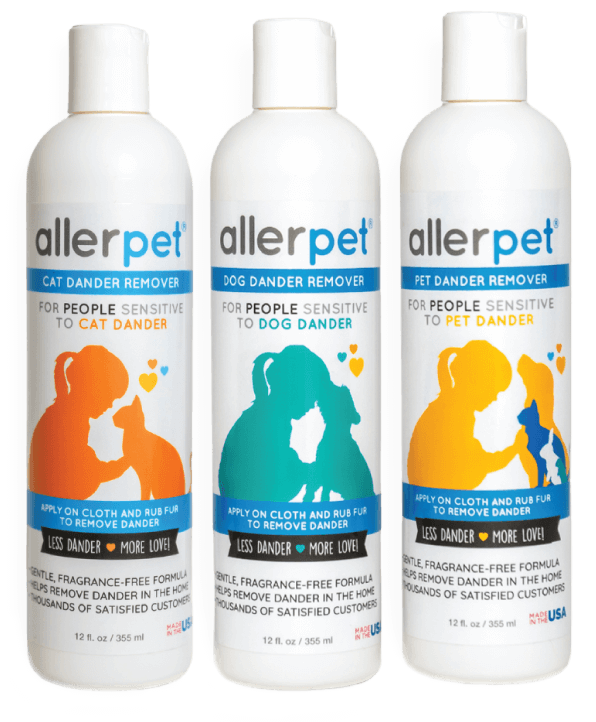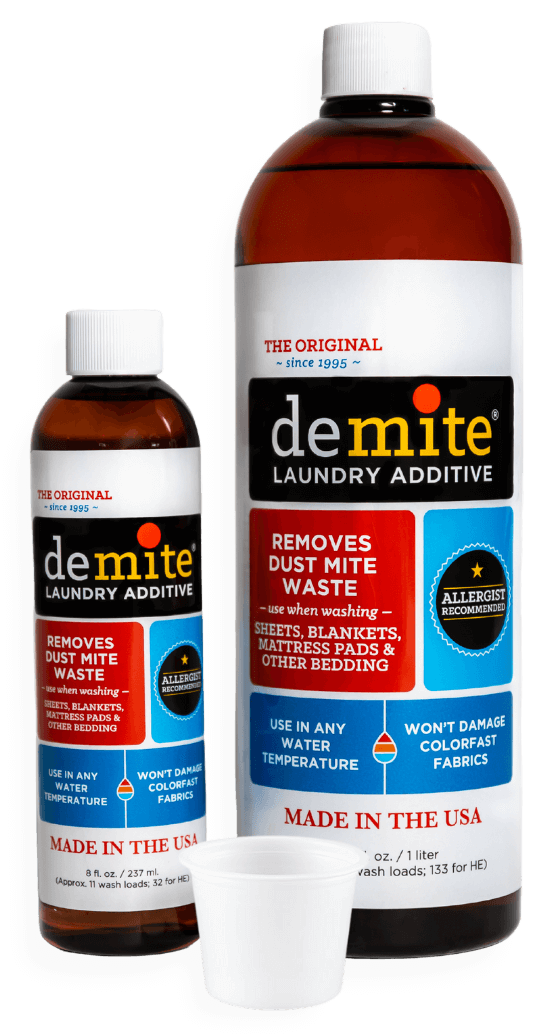How to
Use

DIRECTIONS FOR USE
Allerpet Directions are Easy to Follow
Simple to use: just apply Allerpet to a cloth and wipe your pet to remove dander, reducing the amount you breathe in.
The Allerpet Solution
Allerpet Directions- Overview
Shake bottle before each use.
For the first application, the pet should be brushed or combed to remove as much loose hair as possible, preferably by someone other than the allergic person.
A washcloth should be lightly wetted (not saturated) with Allerpet and thoroughly wiped over the animal, both with and against the lay of the hair. Particular attention needs to be paid to the area surrounding the genitalia, the tail, and other area that the pet tends to self-clean excessively. If the pet is small enough, this procedure can be accomplished while it sits on a towel in the owner’s lap. It is not necessary for the animal to be saturated, just dampened to the skin.
Generally, a once-a-week application should be sufficient for most individuals, but Allerpet may be used as often as necessary without any fear of adverse reactions. Allerpet is gentle and non-irritating. Birds should have their feathers misted every 2 or 3 days.


The Allerpet “Bath”
Detailed Directions for Using Allerpet Dander Remover®
Use Allerpet Pet Dander Remover for all pets or Allerpet Cat Dander Remover for cats, rabbits and small animals or Allerpet Dog Dander Remover for dogs.
The first application of Allerpet can usually be done by the allergic person, however, if he or she is very sensitive, it is better to have it performed by someone else.
Choose something washable to wear when you brush, comb or apply Allerpet to your pet.
Initial Application
STEP 1: If your pet is small enough, especially a cat, let it sit on your lap on a terrycloth towel where it will feel secure. If you have a large dog, stand or let it lay down on a sturdy surface – nothing wobbly or the dog will become frightened and try to jump off.
STEP 2: Use a fine to medium toothed metal comb for cats and a pin or slicker brush for dogs to remove as much dead hair as possible. Break apart any mats or tangles (using your fingers if necessary). Clean the comb or brush frequently and deposit the hair into a waste basket.
Tip: Brushing or combing at least once a week will remove excess dander, foreign matter, dirt, and loose dead hairs that are contaminated with dried salivary, sebaceous and urinary secretions.
STEP 3: Wet a microfiber towel or washcloth with Allerpet, just enough to make it damp, but not enough to drip when lightly squeezed. Wipe it thoroughly over the pet, stroking first against the lay of the hair and then with it. If your pet has long hair, use your free hand to separate the coat to allow you to wipe from the skin outward with the cloth.
Tip: Pay attention to the areas that the pet licks most often, especially around the genitals and the base of the tail where urine residue tends to collect and dry on the hair.
Wash your hands after handling your pet. Try not to touch your face, especially your eyes or nose until you have done so. It’s a good idea to keep a few cleansing wipes handy for emergency use also.
Launder the towel that you spread over your lap and your clothes as soon as you finish, or store them in a separate basket or hamper until they are laundered.
Subsequent Applications
Subsequent applications should be applied once a week as described above. It is safe to use Allerpet more often if necessary.
We recommend that you apply Allerpet once a week; however the product may be used two to three times a week if necessary without any fear of adverse reactions to either the pet or the allergic person. Allerpet is non-toxic and completely safe to use, even on puppies and kittens over the age of 10 weeks and pets that lick themselves a great deal. Brushing or combing is not necessary before every application, but dogs and cats should be kept free of tangles and dead hair for both your health and your pet’s. Concerned care is part of responsible ownership.
The longer a cat or dog resides in your home and is allowed freedom of access to all rooms, the more likely it is that large amounts of Fel d1 and dander will have accumulated. Pet allergens become deeply embedded in the carpets and furniture. Consequently, you may find that you have to apply Allerpet more frequently during the first few weeks, because of the previously deposited Fel d1 and dander.
Allergy sufferers will also find that it is beneficial to brush and comb their cats or dogs regularly, especially those that are permitted to roam out of doors. This will keep tangles that tend to collect dirt, dander and pollen from forming. Even more important, it removes loose hair before it has a chance to circulate throughout the house.
Pets that shed heavily will require more frequent applications of Allerpet.
During dry spells and in arid climates, using a little Allerpet in a spray bottle between applications will be especially helpful.
What to do if it doesn’t work
Allerpet is not a “silver bullet” for those who are allergic to animal dander. The relief you get is subject to the degree of your sensitivity to pet allergens ( and usually other indoor allergens as well). If weekly treatments are not helping as much as you would like for them to, try doing treatments twice a week. In addition, you may need to install a powerful HEPA air cleaner in your bedroom, keep your pet out of that room and vacuum at least weekly with a vacuum cleaner that has an effective final filter, so you don’t just stir up allergens while cleaning, but rather capture them in the machine.
More Tips
ALLERPET IS NOT A CURE ALL . . .
- However, more often than not, it can help you live more comfortably with your pet by removing its pet-related dander before it has a chance to enter into your home environment.
- Bathing your pet is an alternative to using Allerpet. It will definitely help, but it is usually not as effective because of the needed preparations and the experience necessary to properly give a bath, but especially the knowledge of how to rinse the animal thoroughly. The need to go through this process on a weekly basis is a necessity, particularly in the case of cats. Weekly bathing without conditioning tends to dry out the coat and leave excessive dander after a period of time. Over-conditioning oils the coat, attracting dirt and allergens. A big advantage of Allerpet is that you can apply it while watching TV or just relaxing. Cats and small dogs love the grooming.
- Equally important is controlling the dust mite waste contained on your sheets, pillow cases and blankets. It is this debris which is so deeply inhaled. Studies have shown that washing your bedding in very hot water (140 degrees F) will kill most, if not all dust mites. Unfortunately this temperature is safely attainable only in commercial washers. This water temperature also tends to be very hard on fabrics and their colorings.
- Eliminating dust mite waste from your bedding adds significantly to control beyond that of using pillow and matterss encasements only. DeMite Laundry Additive can achieve this control by eliminating virtually all dust mite waste when washing your bedding and undergarments in cool, warm or hot water.
- Central Air Conditioning plays a major role in asthma and to a lesser degree may be related to many indoor allergy problems. Indoor air in today’s energy-efficient, closed environment homes is brimming with microscopic allergens, from dust mite waste to pet dander, pollens and more, all bottled up with nowhere to go. And to make matters worse, this same air is being constantly recirculated throughout the house. If you are considering the purchase a central air conditioner, be certain that it contains a high efficiency filtration system to reduce these allergens as much as possible and to control other airborne bacteria.
- As an alternative to central air conditioning, your doctor may recommend using an air purifier in the bedroom and other rooms to reduce the levels of allergens circulating throughout your home. Air cleaners are effective only on airborne particles, not those that have built up in your carpets, upholstered furniture and bedding.
- A quality free-standing air cleaner will greatly reduce irritating allergens in the room of your choice. Always choose one with a true HEPA filter. HEPA room air cleaners can be a tremendous help in purifying the air. High Efficiency Particulated Air (HEPA) purifiers have the capacity to filter out particles that other air cleanerss miss. A “true” HEPA filter must be able to capture particles of at least .3 microns in size with 99.97 percent efficiency. Anything less efficient is not a true HEPA filter and should only be referred to as a ‘HEPA TYPE’ air cleaner.
- Choose washable curtains and/or shades that are easy to launder or maintain. Avoid long or heavy drapes and Venetian or other kinds of vertical slatted blinds that attract dust and allergens.
- Replace feather pillows with pillows stuffed with synthetics. Check the manufacturer’s instructions for cleaning. If the pillow is washable, launder it regularly adding DeMite Laundry Additive to the water, then tumble it dry in a warm dryer.
- Vacuum around the base of your bed weekly. Remember to vacuum under the bed and to dust the bed frame frequently. All beds throughout the house should be cared for in this manner.
- Conventional vacuums do not retain microscopic particles such as dust mite waste, the cat allergen Fel d 1, animal dander and pollen which are found in carpets by the billions. Yes, they do pick them up, but they immediately recirculate them back into the air you breathe because they are not physically capable of retaining ultra-small particles. Their filtering systems usually retain only particles 50 microns or larger, not efficient enough to collect those that are creating your problems. You should always use a vacuum with true HEPA filtration.
- Carpets are allergen reservoirs. They collect dust and allergens at one hundred times the rate of bare floors. As carpets get older, they begin to harbor more and more allergens . . . dust mite exoskeletons and fecal pellets, animal danders, Fel d 1, house dust, mold growths and outdoor pollens. Bare surfaces, such as hard wood floors or inlaid tiles with washable throw rugs are big deterrents to allergen build-up and are much easier to keep clean than carpets.
- If removal of carpeting is not an option, be certain that it is vacuumed frequently. Work against the pile, stroking several times over each area, overlapping movements to capture as many allergens as possible. Wear a protective mask unless someone else does the vacuuming. The ‘sufferer’ should stay out of the area for one-half hour to let the air settle.
Please see our Pet Allergy Articles pages for more handy tips.
Do you have dust mite allergies?
Take a look at one of our other products, DeMite.
